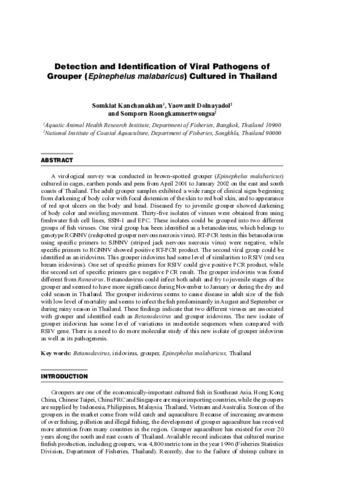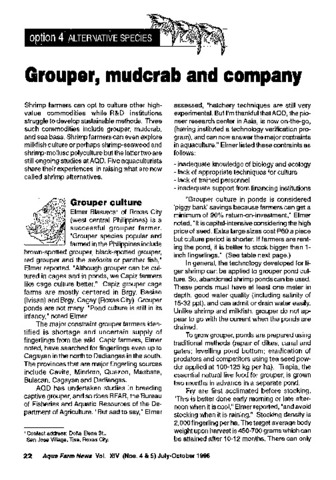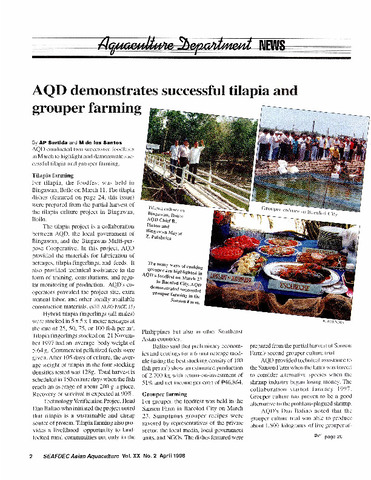Detection and identification of viral pathogens of grouper (Epinephelus malabaricus) cultured in Thailand
- Global styles
- MLA
- Vancouver
- Elsevier - Harvard
- APA
- Help
Share
抄録
A virological survey was conducted in brown-spotted grouper (Epinephelus malabaricus) cultured in cages, earthen ponds and pens from April 2001 to January 2002 on the east and south coasts of Thailand. The adult grouper samples exhibited a wide range of clinical signs beginning from darkening of body color with focal distension of the skin to red boil skin, and to appearance of red spot ulcers on the body and head. Diseased fry to juvenile grouper showed darkening of body color and swirling movement. Thirty-five isolates of viruses were obtained from using freshwater fish cell lines, SSN-1 and EPC. These isolates could be grouped into two different groups of fish viruses. One viral group has been identified as a betanodavirus, which belongs to genotype RGNNV (redspotted grouper nervous necrosis virus). RT-PCR tests in this betanodavirus using specific primers to SJNNV (striped jack nervous necrosis virus) were negative, while specific primers to RGNNV showed positive RT-PCR product. The second viral group could be identified as an iridovirus. This grouper iridovirus had some level of similarities to RSIV (red sea bream iridovirus). One set of specific primers for RSIV could give positive PCR product, while the second set of specific primers gave negative PCR result. The grouper iridovirus was found different from Ranavirus. Betanodavirus could infect both adult and fry to juvenile stages of the grouper and seemed to have more significance during November to January or during the dry and cold season in Thailand. The grouper iridovirus seems to cause disease in adult size of the fish with low level of mortality and seems to infect the fish predominantly in August and September or during rainy season in Thailand. These findings indicate that two different viruses are associated with grouper and identified each as Betanodavirus and grouper iridovirus. The new isolate of grouper iridovirus has some level of variations in nucleotide sequences when compared with RSIV gene. There is a need to do more molecular study of this new isolate of grouper iridovirus as well as its pathogenesis.
Suggested Citation
Kanchanakhan, S., Dolnayadol, Y., & Roongkamnertwongsa, S. (2005). Detection and identification of viral pathogens of grouper (Epinephelus malabaricus) cultured in Thailand. In K. Nagasawa (Ed.), Recent Advances in Diagnosis and Prevention of Fish and Shrimp Diseases in Southeast Asia (pp. 85–94). Tigbauan, Iloilo, Philippines: Aquaculture Department, Southeast Asian Fisheries Development Center.
Type
Book chapterISBN
9718511732
Related items
Showing items related by title, author, creator and subject.
-
Culture of grouper, sea bass and red snapper
Toledo, Joebert D. (University of the Philippines Aquaculture Society, Inc., 2001)Marine fish production has increased dramatically in the past ten years and majority of the cultured species were produced in Asia in 1992. Increase in production was accompanied with concerns on increasing outbreak of ... -
Grouper, mudcrab and company
Southeast Asian Fisheries Development Center, Aquaculture Department (Aquaculture Department, Southeast Asian Fisheries Development Center, 1996)The paper discusses aquaculture practices on the three other high-value commodities which can be cultured as an alternative to shrimp. These species are grouper, mud crab and sea bass, it also discusses milkfish aquaculture ... -
AQD demonstrates successful tilapia and grouper farming
Surtida, Augusto P.; de los Santos, M. (Aquaculture Department, Southeast Asian Fisheries Development Center, 1998)


 AQD Access
AQD Access



